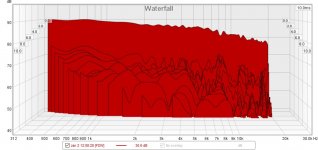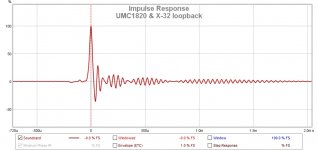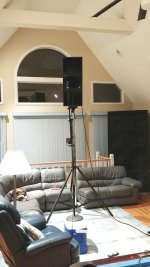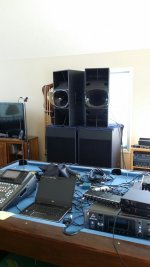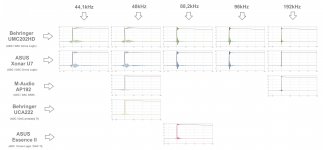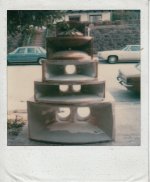Nice measurements, how did you get so clean results without an obvious room?
Another question, at what distance was this measurement taken?
I think the measurement is indeed affected by REW determining the peak value of the IR.
The hash could be a number of things, a bit of diffraction of high frequencies, obviously the filtered IR shows a very clear pulse and no real reflections, however it is still "only" a chosen representation.
You can use filters (left bottom on that graph), to look at filtered frequencies. You might find which frequency is higher after the peak than the representation by trying different frequencies like 8000 Hz, 1/3 octave etc.
Have you tried to let REW re-adjust the timing? On the IR tab, where the impulse is shown, click on the controls (upper right) and in that panel click on the estimate IR delay.
This might align the phase and get the peak back to a rightful 100%.
The fuzz isn't the cause of the subtle rise and fall of the STEP. The slightly declining frequency response is doing that. You could mimic it with RePhase. Take a perfect IR, make it slope down with the same slope you have in your measurement of the frequency and watch a perfect IR and STEP. It won't be too far off from what you're seeing.
I must say, fun project! Please show some photo's, maybe in a thread of it's own not to clutter this one. I'm interested in anything that measures like this!
I'd like to see more. Well done I say! Did my thread help at all? It's kinda big .
.
Another question, at what distance was this measurement taken?
I think the measurement is indeed affected by REW determining the peak value of the IR.
The hash could be a number of things, a bit of diffraction of high frequencies, obviously the filtered IR shows a very clear pulse and no real reflections, however it is still "only" a chosen representation.
You can use filters (left bottom on that graph), to look at filtered frequencies. You might find which frequency is higher after the peak than the representation by trying different frequencies like 8000 Hz, 1/3 octave etc.
Have you tried to let REW re-adjust the timing? On the IR tab, where the impulse is shown, click on the controls (upper right) and in that panel click on the estimate IR delay.
This might align the phase and get the peak back to a rightful 100%.
The fuzz isn't the cause of the subtle rise and fall of the STEP. The slightly declining frequency response is doing that. You could mimic it with RePhase. Take a perfect IR, make it slope down with the same slope you have in your measurement of the frequency and watch a perfect IR and STEP. It won't be too far off from what you're seeing.
I must say, fun project! Please show some photo's, maybe in a thread of it's own not to clutter this one. I'm interested in anything that measures like this!
I'd like to see more. Well done I say! Did my thread help at all? It's kinda big
Thanks Wesayso !!!
The speaker is on a stand about 9 ft off the ground, in a room with a 16 ft vaulted ceiling. Room is about 26' x 17'. So there's a little breathing room before reflections.
Mic is about 8' off floor and 4-5ft from the speaker which tilts down a little to aim at mic.
I do let REW adjust the timing as a first step after every measurement. My understand is that the 'Estimate IR delay' buttons on the Impulse tab and SPL & Phase tab, are one and the same button, effecting exactly the same things. Is this correct?
Measurements are against a loopback that includes a behringer UMC1820 USB interface and a X-32 mixer. I use this loop because it's the same total loop I use for Smaart.
I need to get to where I fully understand how REW estimates delay.
I know Smaart has some algorithm for finding frequency of peak energy, signal A vs signal B, and pins delay there.
I think REW does the same thing, but instead of doing a straight A to B comparison, REW does it A against a calculated minimum phase B. I'm fishing here....
I did try looking at 1/3 octave Filtered IR throughout the spectrum for timing differences. Couldn't really find any.
Yes, it does seem like a filtered impulse response is too clean to offer much info...that's why I didn't bother with posting a windowed impulse.
I'll try mimicking STEP with rePhase as you suggest...maybe that will help illuminate what we are trying to achieve in STEP..
And a big Yes..... your thread (which took days! to read thru lol) helped a lot. Watching you work through your ongoing measurements, and trying to take in all the comments from the other guys gave me a very good start here.
Thx again for the kind comments. I will post some picts and further system details in another thread tomorrow.
The speaker is on a stand about 9 ft off the ground, in a room with a 16 ft vaulted ceiling. Room is about 26' x 17'. So there's a little breathing room before reflections.
Mic is about 8' off floor and 4-5ft from the speaker which tilts down a little to aim at mic.
I do let REW adjust the timing as a first step after every measurement. My understand is that the 'Estimate IR delay' buttons on the Impulse tab and SPL & Phase tab, are one and the same button, effecting exactly the same things. Is this correct?
Measurements are against a loopback that includes a behringer UMC1820 USB interface and a X-32 mixer. I use this loop because it's the same total loop I use for Smaart.
I need to get to where I fully understand how REW estimates delay.
I know Smaart has some algorithm for finding frequency of peak energy, signal A vs signal B, and pins delay there.
I think REW does the same thing, but instead of doing a straight A to B comparison, REW does it A against a calculated minimum phase B. I'm fishing here....
I did try looking at 1/3 octave Filtered IR throughout the spectrum for timing differences. Couldn't really find any.
Yes, it does seem like a filtered impulse response is too clean to offer much info...that's why I didn't bother with posting a windowed impulse.
I'll try mimicking STEP with rePhase as you suggest...maybe that will help illuminate what we are trying to achieve in STEP..
And a big Yes..... your thread (which took days! to read thru lol) helped a lot. Watching you work through your ongoing measurements, and trying to take in all the comments from the other guys gave me a very good start here.
Thx again for the kind comments. I will post some picts and further system details in another thread tomorrow.
I think I found some posts of you over on soundforums so I may have seen the setup, but I think it will still be worth it to put up some posts over here.
As we see the initial peak overshoot the zero point something doesn't line up in REW. As you are using loop back it should know as it would compare the time of travel to that input loopback signal. I haven't used loopback in my measurements so I can't be of any help there. Usually people with loop back have the impulse start right at the measured delay, at least that's how I've seen it. Hope someone with loop back experience can help.
I've read some of that thread over on Soundforums, quite the company is involved there, I saw Raimonds Skuruls from APL post there too. And some familiar names from this forum. It made me say up way too late!
I was thinking about the wiggles, could be a number of things.(*) If you're relying on REW's auto EQ, you may be able to do better with some manual tweaks. On the EQ tab make sure to see the impulse or an early waterfall plot on the bottom graph. That will give you a visual queue of what's happening.
Talking about early waterfall graphs, they might show the reason for the wiggles. Look at the very early signal to maybe get a clue of what's happening.
Something like these settings:

I wouldn't know for sure, but I'd suspect some vibration of something in the enclosure might be causing wiggles that early. Could be the horn body, did you damp it?
If not, I'd isolate the horn body from the rigid enclosure with neoprene, sorbothane or butylrope. Place rubber rings under the screws that hold it. Cover the body of that horn with some automotive damping material, the good stuff using butyl and a thin alu layer. I use Silent Coat 4 mm but that's because it's more local over here. Lots of brands, though not all brands have the same results. I guess Dynamatt should be ok. Lots of info on diymobileaudio.com.
But I'm assuming here, lets first see the early waterfall plot.
If I did see your graphs in the Soundforums, you've had a bottom end under it with phase correction down to the low numbers, how did that sound? Did you listen to Stereo that way?
(*) if the actual peak isn't aligned at zero, the wiggles will change a bit.
As we see the initial peak overshoot the zero point something doesn't line up in REW. As you are using loop back it should know as it would compare the time of travel to that input loopback signal. I haven't used loopback in my measurements so I can't be of any help there. Usually people with loop back have the impulse start right at the measured delay, at least that's how I've seen it. Hope someone with loop back experience can help.
I've read some of that thread over on Soundforums, quite the company is involved there, I saw Raimonds Skuruls from APL post there too. And some familiar names from this forum. It made me say up way too late!
I was thinking about the wiggles, could be a number of things.(*) If you're relying on REW's auto EQ, you may be able to do better with some manual tweaks. On the EQ tab make sure to see the impulse or an early waterfall plot on the bottom graph. That will give you a visual queue of what's happening.
Talking about early waterfall graphs, they might show the reason for the wiggles. Look at the very early signal to maybe get a clue of what's happening.
Something like these settings:

I wouldn't know for sure, but I'd suspect some vibration of something in the enclosure might be causing wiggles that early. Could be the horn body, did you damp it?
If not, I'd isolate the horn body from the rigid enclosure with neoprene, sorbothane or butylrope. Place rubber rings under the screws that hold it. Cover the body of that horn with some automotive damping material, the good stuff using butyl and a thin alu layer. I use Silent Coat 4 mm but that's because it's more local over here. Lots of brands, though not all brands have the same results. I guess Dynamatt should be ok. Lots of info on diymobileaudio.com.
But I'm assuming here, lets first see the early waterfall plot.
If I did see your graphs in the Soundforums, you've had a bottom end under it with phase correction down to the low numbers, how did that sound? Did you listen to Stereo that way?
(*) if the actual peak isn't aligned at zero, the wiggles will change a bit.
Last edited:
Yep, you no doubt found me on soundforums. It's been a very fun project...and like here, the guys are great in helping. Heaven knows I've needed help !
I've built both versions, the 60 degree and the 90 degree. It's the 60 degree I'm working on here.
The waterfall is with the settings you gave. Are the ridges in the higher frequencies, particularly at around 8kHz, the possible root of the wiggles?
It would be great if HF horn resonances, or maybe even CD driver to horn throat mismatches, are the cause, as these might be fixable. I'll work on dampening the horn, an eighteen sound XT1464. The horns throat is also a slight bit larger in diameter than the CD exit. I haven't really figured out how to smooth that out other than a lame attempt with some beeswax.
It would be great because if it's not the high end, and the wiggles are due to the low end, I doubt anything can be done? The folded-horn low end is simply going to have ripples I think...?
I guess that's the price of so much power in a relatively small box. Did you see the sensitivity post I put up? https://soundforums.net/forum/low-e...2390-60-degree-diy-mid-hi?p=203758#post203758
https://soundforums.net/forum/low-e...2390-60-degree-diy-mid-hi?p=203758#post203758
Yes, I've been trying to get phase flat as low as possible...still trying lol...I need miniDSP to allow an openDRC to use all of its 12288 taps in mono !
So far, I've gotten fairly flat to maybe 40 Hz, and what I've heard stereo indoors is promising. Bass almost sounds like there is less bass, until I realize I'm hearing a clearer more dynamic sound...and still feeling all the vibration I'm used to. But I really won't know until I can set up outside for some extended comparing to a more traditional IIR group delay...
I do already believe though, that at least the subs electrical bandpass filters should be linearized... I mean, why not, what's to lose?
I've built both versions, the 60 degree and the 90 degree. It's the 60 degree I'm working on here.
The waterfall is with the settings you gave. Are the ridges in the higher frequencies, particularly at around 8kHz, the possible root of the wiggles?
It would be great if HF horn resonances, or maybe even CD driver to horn throat mismatches, are the cause, as these might be fixable. I'll work on dampening the horn, an eighteen sound XT1464. The horns throat is also a slight bit larger in diameter than the CD exit. I haven't really figured out how to smooth that out other than a lame attempt with some beeswax.
It would be great because if it's not the high end, and the wiggles are due to the low end, I doubt anything can be done? The folded-horn low end is simply going to have ripples I think...?
I guess that's the price of so much power in a relatively small box. Did you see the sensitivity post I put up?
Yes, I've been trying to get phase flat as low as possible...still trying lol...I need miniDSP to allow an openDRC to use all of its 12288 taps in mono !
So far, I've gotten fairly flat to maybe 40 Hz, and what I've heard stereo indoors is promising. Bass almost sounds like there is less bass, until I realize I'm hearing a clearer more dynamic sound...and still feeling all the vibration I'm used to. But I really won't know until I can set up outside for some extended comparing to a more traditional IIR group delay...
I do already believe though, that at least the subs electrical bandpass filters should be linearized... I mean, why not, what's to lose?
Attachments
Great measurements Mark100!
Some the ringing after the IR peak may indeed be related to the speaker (dispersion, etc.) It's likely that most of that ringing is due to the measuring system. A loopback measurement of the measuring system (or just the soundcard) will give some idea of this. One can measure the distance between the ripple peaks and calculate the frequency. A very rough estimate from the chart above suggests that this measurement was done at a 24 kHz sampling frequency. The ripples are basically a small leakage of the Nyquist frequency past the reconstruction filter of the soundcard. Small ripples also show up in the step response, but there they are very small as the high frequency emphasis of the IR is replaced with uniform weighting of the frequencies in step response.
The rounded peak of the step response is probably just due to the SPL HF roll-off. Roll-off of the HF SPL will cause the step response to lose the initial sharp peak. EQ the speaker so the SPL is flat (as a trial) and shape will look more ideal.
There are various algorithms to estimate the IR placement. REW has 2 choices and HolmImpulse has several. No one answer is correct for all uses. Just manually adjust the IR location as desired for the analysis. If we want the above phase chart to look flatter at HF just move the IR back so to the peak is closer to 0 ms. [Possibly, if the SPL had been EQed flatter, the chosen REW IR positioning algorithm would have placed the peak nearer 0 ms with the phase then flatter appearing at 0°.]
Some the ringing after the IR peak may indeed be related to the speaker (dispersion, etc.) It's likely that most of that ringing is due to the measuring system. A loopback measurement of the measuring system (or just the soundcard) will give some idea of this. One can measure the distance between the ripple peaks and calculate the frequency. A very rough estimate from the chart above suggests that this measurement was done at a 24 kHz sampling frequency. The ripples are basically a small leakage of the Nyquist frequency past the reconstruction filter of the soundcard. Small ripples also show up in the step response, but there they are very small as the high frequency emphasis of the IR is replaced with uniform weighting of the frequencies in step response.
The rounded peak of the step response is probably just due to the SPL HF roll-off. Roll-off of the HF SPL will cause the step response to lose the initial sharp peak. EQ the speaker so the SPL is flat (as a trial) and shape will look more ideal.
There are various algorithms to estimate the IR placement. REW has 2 choices and HolmImpulse has several. No one answer is correct for all uses. Just manually adjust the IR location as desired for the analysis. If we want the above phase chart to look flatter at HF just move the IR back so to the peak is closer to 0 ms. [Possibly, if the SPL had been EQed flatter, the chosen REW IR positioning algorithm would have placed the peak nearer 0 ms with the phase then flatter appearing at 0°.]
Yep, you no doubt found me on soundforums. It's been a very fun project...and like here, the guys are great in helping. Heaven knows I've needed help !
I've built both versions, the 60 degree and the 90 degree. It's the 60 degree I'm working on here.
The waterfall is with the settings you gave. Are the ridges in the higher frequencies, particularly at around 8kHz, the possible root of the wiggles?
It would be great if HF horn resonances, or maybe even CD driver to horn throat mismatches, are the cause, as these might be fixable. I'll work on dampening the horn, an eighteen sound XT1464. The horns throat is also a slight bit larger in diameter than the CD exit. I haven't really figured out how to smooth that out other than a lame attempt with some beeswax.
It would be great because if it's not the high end, and the wiggles are due to the low end, I doubt anything can be done? The folded-horn low end is simply going to have ripples I think...?
I guess that's the price of so much power in a relatively small box. Did you see the sensitivity post I put up?https://soundforums.net/forum/low-e...2390-60-degree-diy-mid-hi?p=203758#post203758
Yes, I've been trying to get phase flat as low as possible...still trying lol...I need miniDSP to allow an openDRC to use all of its 12288 taps in mono !
So far, I've gotten fairly flat to maybe 40 Hz, and what I've heard stereo indoors is promising. Bass almost sounds like there is less bass, until I realize I'm hearing a clearer more dynamic sound...and still feeling all the vibration I'm used to. But I really won't know until I can set up outside for some extended comparing to a more traditional IIR group delay...
I do already believe though, that at least the subs electrical bandpass filters should be linearized... I mean, why not, what's to lose?
I expect those ripples at 8 KHz is what you're seeing in the IR. The cause of that? some form of vibration maybe, but this plot is pretty clean already. Some manual EQ tweaks might bring down those ridges. It would be immediately evident in the IR and Waterfall.
Are you willing to post a measurement? I'd love to take a look.
The way you describe the phase linearization. That's pretty much how I feel about it. It isn't louder, but brings more power to the whole spectrum. You hear it, feel it and it's more dynamic, as in real life. Hard to explain, you've got to hear it I guess.
First align the peak at zero, the ripple will change. JTalden is right, even a DAC by itself shows some ripple with a loop back. I've used that to optimise Asio buffers.
At some point you've got to say: don't worry, be happy
Last edited:
Wesayso, of course.... is there a way to attach a mdat file? or rather how do i get it to you?
I ordered a pack of Silent Coat 4mm that I found over here...been meaning to try this on the XT1464 forever....
I see what you and jtalden are saying regarding sound card ripple..
Jtalden, many thanks for the reply. I've attached an impulse of the soundcard & mixer calibration file that I'm using. Wow, I never dreamed it would be so wiggly. I guess I need to get used used to peering in closely in time. (Both soundcard and mixer are running at 48 kHz.)
BYRTT and xrk971, thanks for the kind comments
But really, the only work I've done is simply follow others plans, advice, and help....maybe someday, hopefully, I can actually contribute something...
It's the most dynamic sound I've heard yet. I've heard better imaging and soundfield presentation, but nothing that images as well as it does combined with so much sheer raw power and dynamic impact.
I'm very happy with how the box sounds...if no further improvement is possible, so be it. I really just want to keep learning.....
I've attached a couple of photos, but with some concern for veering off topic from rePhase...which by the way POS, thanks so much for the EQ implementation with REW, and also for the EQ bypasses and reordering...it REALLY helps, with manual EQ especially.
First pict is current measurement setup, second is a better pict of the DIY60's, and is one from the set of "And I wonder why she left me?"
I ordered a pack of Silent Coat 4mm that I found over here...been meaning to try this on the XT1464 forever....
I see what you and jtalden are saying regarding sound card ripple..
Jtalden, many thanks for the reply. I've attached an impulse of the soundcard & mixer calibration file that I'm using. Wow, I never dreamed it would be so wiggly. I guess I need to get used used to peering in closely in time. (Both soundcard and mixer are running at 48 kHz.)
BYRTT and xrk971, thanks for the kind comments
But really, the only work I've done is simply follow others plans, advice, and help....maybe someday, hopefully, I can actually contribute something...
It's the most dynamic sound I've heard yet. I've heard better imaging and soundfield presentation, but nothing that images as well as it does combined with so much sheer raw power and dynamic impact.
I'm very happy with how the box sounds...if no further improvement is possible, so be it. I really just want to keep learning.....
I've attached a couple of photos, but with some concern for veering off topic from rePhase...which by the way POS, thanks so much for the EQ implementation with REW, and also for the EQ bypasses and reordering...it REALLY helps, with manual EQ especially.
First pict is current measurement setup, second is a better pict of the DIY60's, and is one from the set of "And I wonder why she left me?"
Attachments
That's quite a wiggle you got there. I'll PM you an email address for the measurement. But seeing the impulse from the card I think we already know the answer.
A mismatch between software and hardware can give strange results. Setting everything to the same 48 KHz may help, but not if you want to play 44.100 files.
I've managed to clean up my IR, there's still some small ripple above the hearing threshold.
Yours looks like a mismatch between 44.1 and 48 somewhere in the chain.
A mismatch between software and hardware can give strange results. Setting everything to the same 48 KHz may help, but not if you want to play 44.100 files.
I've managed to clean up my IR, there's still some small ripple above the hearing threshold.
Yours looks like a mismatch between 44.1 and 48 somewhere in the chain.
AIUI the "Estimate IR Delay" button in REW is calculated from a cross correlation of the measurement against the minimum phase version of the measured response. This option is available whether you've used any form of loopback or not.I need to get to where I fully understand how REW estimates delay.
I know Smaart has some algorithm for finding frequency of peak energy, signal A vs signal B, and pins delay there.
I think REW does the same thing, but instead of doing a straight A to B comparison, REW does it A against a calculated minimum phase B. I'm fishing here....
If you use a loopback (whether using the acoustic timing reference option or via a physical or electronic loopback of the measurement signal) then the impulse will be placed relative to that reference signal.
It sounds like your setup is the latter but you are talking in terms of the former.
AIUI the "Estimate IR Delay" button in REW is calculated from a cross correlation of the measurement against the minimum phase version of the measured response. This option is available whether you've used any form of loopback or not.
If you use a loopback (whether using the acoustic timing reference option or via a physical or electronic loopback of the measurement signal) then the impulse will be placed relative to that reference signal.
It sounds like your setup is the latter but you are talking in terms of the former.
Thanks!! That confirms what I thought, that "Estimate IR delay" is against a calculated minimum phase curve.
...I've attached an impulse of the soundcard & mixer calibration file that I'm using. Wow, I never dreamed it would be so wiggly. I guess I need to get used used to peering in closely in time. (Both soundcard and mixer are running at 48 kHz.)...
Its F-word irritating with those ringing bells, well sometimes i suspect its because all new silicon is so wideband and real good than to distinguish their cheap products from expensive products they by purpose makes those flawing filters. Had not all my tests at hand at this moment but the ones i found you see below and heck why could they in past make normal good filters on the ones in middle. The two modern ones at top are only looking clean or normal up at 192kHz which means if we lock them there other tricks when playing with lower resolution tracks needs to be executed. All tests are ASIO (except UCA222) clean loopback with no other devices in chain but admit we can't know if ringing is input or output or a combination of the two.
...BYRTT and xrk971, thanks for the kind comments
But really, the only work I've done is simply follow others plans, advice, and help....maybe someday, hopefully, I can actually contribute something...
Welcome, think most study and learn from each other but for your build you the one that investigated and executed tons of details ending up what looks a excellent acoustic performer.
Attachments
Sorry for the off-topic, but when I see this:
I can't help wondering about the performance of even bigger (folded or tapped) horns with 15" or 18" wrapped around this one on both sides to make a Dunlavy style WMTMW on steroids.

Filtered with REW/RePhase you would have something!
An externally hosted image should be here but it was not working when we last tested it.
I can't help wondering about the performance of even bigger (folded or tapped) horns with 15" or 18" wrapped around this one on both sides to make a Dunlavy style WMTMW on steroids.
Filtered with REW/RePhase you would have something!
Mark100, your build looks stunning!
Looking at your second photo they actually look pretty small and living-room-friendly...
I can only imagine how good they sound, especially in free field.
It looks like phase linearity becomes more audible with increased SPL.
Isn't latency a problem with your application?
Looking at your second photo they actually look pretty small and living-room-friendly...
I can only imagine how good they sound, especially in free field.
It looks like phase linearity becomes more audible with increased SPL.
Isn't latency a problem with your application?
Mark100, your build looks stunning!
Looking at your second photo they actually look pretty small and living-room-friendly...
I can only imagine how good they sound, especially in free field.
It looks like phase linearity becomes more audible with increased SPL.
Isn't latency a problem with your application?
Thank You POS !
They sound dang good inside, but you're right, free field needs to be heard.
Yes, latency....sigh...
But my use of this box that is designed for live sound, is mostly playback. I do have a set of files to load in the miniDSP boxes to bring system latency down to about 22ms when needed..
I can't really discuss tuning at any higher latency than that on the live sound forums....it's just not fair to talk about achieving great sound, with a non-starter for them.
I'm at 64ms for sub and mid correction (openDRC 6144taps) plus about 10-11 ms of physical sub length (FLH), for a total latency of about 75 ms.
I keep clamoring to the miniDSP folks to build a plugin for 12288 mono taps...I've run so many rePhase trials trying to optimize as low as possible.
Currently toying with cascading 6144 taps of openDRC with 2300 taps of fine tuning in a ICE amp.
I've said it before...rePhase rocks ! thank you !
I think downsampling the entier system would bring more benefits:I keep clamoring to the miniDSP folks to build a plugin for 12288 mono taps...I've run so many rePhase trials trying to optimize as low as possible.
https://www.minidsp.com/forum/suggestion-box/10749-32khz-opendrc-plugin
So you are using the new FIR plugin recently released for the PWR?Currently toying with cascading 6144 taps of openDRC with 2300 taps of fine tuning in a ICE amp.
Those little plate amp look really interesting now for a small two way
 .
.How do you like them?
My pleasureI've said it before...rePhase rocks ! thank you !
I think downsampling the entier system would bring more benefits:
https://www.minidsp.com/forum/suggestion-box/10749-32khz-opendrc-plugin
So you are using the new FIR plugin recently released for the PWR?
Those little plate amp look really interesting now for a small two way.
How do you like them?
My pleasure
Downsampling would be nice...
....and I take it you mean to allow for implementations in a Four-Audio type way....? Four Audio | FIR Filters: calculation power, length of impulse responses, and frequency resolution
I kinda made the same suggestion https://www.minidsp.com/forum/sugge...c-12288-mono-taps-or-lower-sample-rates#27931
I've only had the amp for about a week, but I like it enough that I've ordered a second one for stereo. I wanted it for its AES input, trying to eliminate some of the numerous AD/DA conversions in my signal chain. Also wanted silent operation indoors, vs my loud fan QSC amps (for outdoors).
Looking forward to measuring amp output and see how things have apparently cleaned up. They do sound great to me.
I've used the FIR plugins to make para-gain and para-phase adjustments, on top of the main FIR files in the openDRC boxes.....as opposed to regenerating the main files with adjustments. I really like this approach, as I can build the ICE's adjustment files on my desktop PC and load them via ethernet. When finalized, I'll embed all adjustments in the main files....if I can. I'm beginning to think there might be advantage to keeping it split, as sometimes adjustments down low don't fully take in the regenerated main FIR. Plus the dang openDRC's don't keep the file names in memory, and as I try many adjustments, I can get the main files really screwed up !
The plate amps do look very interesting for a small two-way....I guess as long as the crossover is high enough. For my 650Hz crossover point, 300 taps struggles a little with the slope I'd like to use. It would be nice if the plugin allowed a little flexibility here....
- Home
- Design & Build
- Software Tools
- rePhase, a loudspeaker phase linearization, EQ and FIR filtering tool
